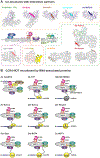Regulation of the multisubunit CCR4-NOT deadenylase in the initiation of mRNA degradation
- PMID: 36116370
- PMCID: PMC9771892
- DOI: 10.1016/j.sbi.2022.102460
Regulation of the multisubunit CCR4-NOT deadenylase in the initiation of mRNA degradation
Abstract
The conserved CCR4-NOT complex initiates the decay of mRNAs by catalyzing the shortening of their poly(A) tails in a process known as deadenylation. Recent studies have provided mechanistic insights into the action and regulation of this molecular machine. The two catalytic enzymatic subunits of the complex hydrolyze polyadenosine RNA. Notably, the non-catalytic subunits substantially enhance the complex's affinity and sequence selectivity for polyadenosine by directly contacting the RNA. An additional regulatory mechanism is the active recruitment of the CCR4-NOT to transcripts targeted for decay by RNA-binding proteins that recognize motifs or sequences residing predominantly in untranslated regions. This targeting and strict control of the mRNA deadenylation process emerges as a crucial nexus during post-transcriptional regulation of gene expression.
Published by Elsevier Ltd.
Conflict of interest statement
Conflict of interest statement
The authors declare no conflict of interest.
Figures



Similar articles
-
Tryptophan-Mediated Interactions between Tristetraprolin and the CNOT9 Subunit Are Required for CCR4-NOT Deadenylase Complex Recruitment.J Mol Biol. 2018 Mar 2;430(5):722-736. doi: 10.1016/j.jmb.2017.12.018. Epub 2017 Dec 29. J Mol Biol. 2018. PMID: 29291391
-
Genome-Wide Mapping of Decay Factor-mRNA Interactions in Yeast Identifies Nutrient-Responsive Transcripts as Targets of the Deadenylase Ccr4.G3 (Bethesda). 2018 Jan 4;8(1):315-330. doi: 10.1534/g3.117.300415. G3 (Bethesda). 2018. PMID: 29158339 Free PMC article.
-
CCR4-NOT deadenylates mRNA associated with RNA-induced silencing complexes in human cells.Mol Cell Biol. 2010 Mar;30(6):1486-94. doi: 10.1128/MCB.01481-09. Epub 2010 Jan 11. Mol Cell Biol. 2010. PMID: 20065043 Free PMC article.
-
Regulation of eukaryotic mRNA deadenylation and degradation by the Ccr4-Not complex.Front Cell Dev Biol. 2023 Apr 20;11:1153624. doi: 10.3389/fcell.2023.1153624. eCollection 2023. Front Cell Dev Biol. 2023. PMID: 37152278 Free PMC article. Review.
-
Regulation of Early Lymphocyte Development via mRNA Decay Catalyzed by the CCR4-NOT Complex.Front Immunol. 2021 Jul 19;12:715675. doi: 10.3389/fimmu.2021.715675. eCollection 2021. Front Immunol. 2021. PMID: 34349771 Free PMC article. Review.
Cited by
-
Reconstitution of Human CCR4-NOT Complex from Purified Proteins and an Assay of Its Deadenylation Activity.Methods Mol Biol. 2024;2723:1-17. doi: 10.1007/978-1-0716-3481-3_1. Methods Mol Biol. 2024. PMID: 37824061
-
A unique poly(A) tail profile uncovers the stability and translational activation of TOP transcripts during neuronal differentiation.iScience. 2023 Jul 27;26(9):107511. doi: 10.1016/j.isci.2023.107511. eCollection 2023 Sep 15. iScience. 2023. PMID: 37636056 Free PMC article.
-
Functional Proximity across an mRNA.Biochemistry. 2025 Aug 12:10.1021/acs.biochem.5c00340. doi: 10.1021/acs.biochem.5c00340. Online ahead of print. Biochemistry. 2025. PMID: 40792674 Free PMC article.
-
Differential Poly(A) Tail Length Analysis Using Nanopore Sequencing.Methods Mol Biol. 2024;2723:267-283. doi: 10.1007/978-1-0716-3481-3_16. Methods Mol Biol. 2024. PMID: 37824076
-
Hydrodynamic Radii of Intrinsically Disordered Proteins: Fast Prediction by Minimum Dissipation Approximation and Experimental Validation.J Phys Chem Lett. 2024 May 16;15(19):5024-5033. doi: 10.1021/acs.jpclett.4c00312. Epub 2024 May 2. J Phys Chem Lett. 2024. PMID: 38696815 Free PMC article.
References
-
- Garneau NL, Wilusz J, Wilusz CJ: The highways and byways of mRNA decay. Nat Rev Mol Cell Biol 2007, 8:113–126. - PubMed
-
- Wahle E, Winkler GS: RNA decay machines: deadenylation by the Ccr4-not and Pan2-Pan3 complexes. Biochim Biophys Acta 2013, 1829:561–570. - PubMed
-
- Uchida N, Hoshino S-I, Katada T: Identification of a Human Cytoplasmic Poly(A) Nuclease Complex Stimulated by Poly(A)-binding Protein*. J Biol Chem 2004, 279:1383–1391. - PubMed
-
- Yamashita A, Chang T-C, Yamashita Y, Zhu W, Zhong Z, Chen C-YA, Shyu A-B: Concerted action of poly(A) nucleases and decapping enzyme in mammalian mRNA turnover. Nat Struct Mol Biol 2005, 12:1054–1063. - PubMed
Publication types
MeSH terms
Substances
Grants and funding
LinkOut - more resources
Full Text Sources

